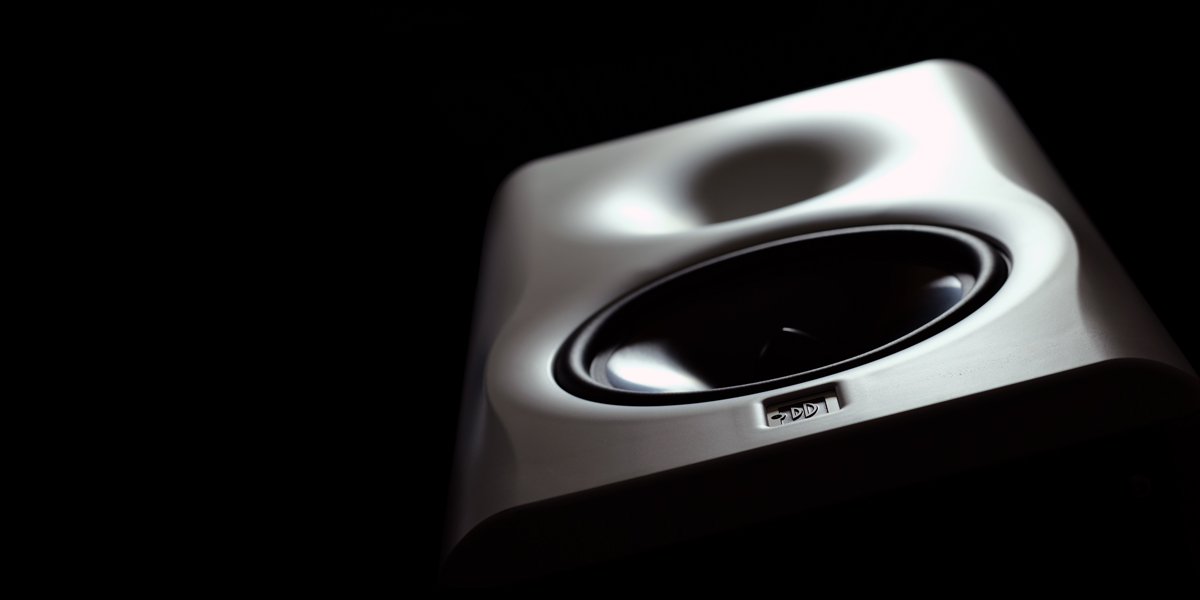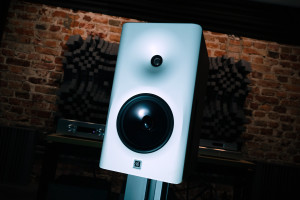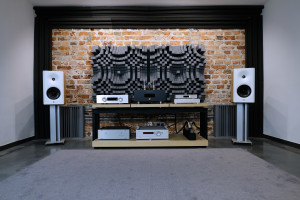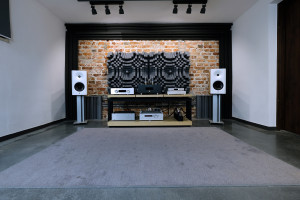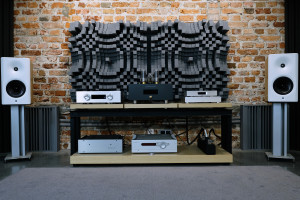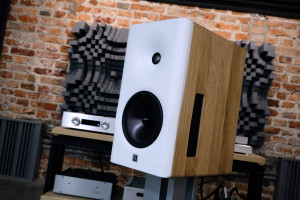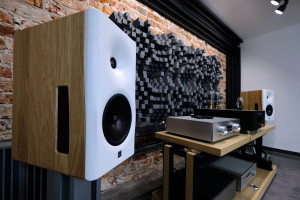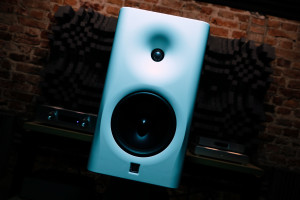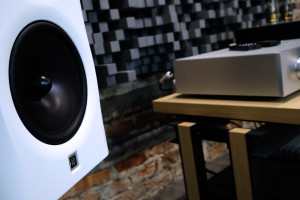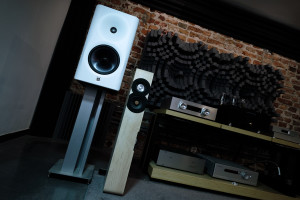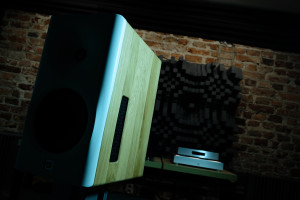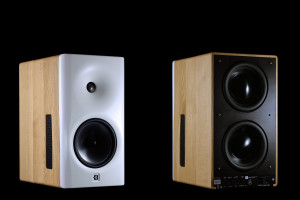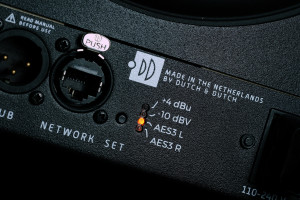If you’ve been ever wondering whether an all-in-one product can stand up to a far costlier setup of regular sort or even surpass it, this report might have just the answer. Dutch & Dutch 8c has arrived and rather effortlessly managed to turn things upside down. Enjoy!
Introduction
This hobby of ours undoubtedly is full of stereotypes and regular setups seen as the only way to audio nirvana is probably the most common one out there. Not only this, we fare quite comfy lives within our own bubbles filled with regular speakers, amps, DACs, cables and any other fitting hardware. If several synergistically married components are what it takes to get us there, so be it. That’s perfectly fine. Many people would actually say that the more items involved the merrier, due to extensive triangulations enabled in order to pursue improvements or different sound flavours. That all by itself can be and oftentimes is nothing short but plain fun. Still, audio goes far beyond classic rigs, alternate solutions do exist. We’re fortunate to live in times when a well-thought and finely executed all-in-one audio product can net a result respectable enough to leave many heavyweight enthusiasts thoroughly impressed. Several specimens of this rare sort emerged in recent years and this writing is about one of them. In May 2018 in Munich yours truly got familiar with two highly interesting items which didn’t resemble his regular system at all. Picture visually modern products loaded with all necessary electronics. Such turnkey affairs many would consider very much mainstream, but these two were clearly designed to impress with sound and they did just that. Far from perfect as they usually are, exhibition conditions didn’t allow this intrigued reporter to do anything other than barely scratch the proverbial surface, but surely made him hungry for more. This year Grimm Audio LS1be speakers located somewhere in MOC’s atrium area and Kii Audio Three monitors married to their bass modules found downstairs were the reason behind his enormous appetite. These products sounded very promising not only as specimens within their own and rather unusual category, but in general classification as well. Although far more affordable and held in high regard by many, neither Devialet Phantom nor wireless KEF LS50 impressed me this much. Not even close. Of all similar systems heard thus far, what the LS1be pulled off was easily the most remarkable show to my ears. Needless to say, this product seemed to be a perfect sparring partner for my reference setup.
In May 2018 in Munich yours truly got familiar with two highly interesting items which didn’t resemble his regular system at all. Picture visually modern products loaded with all necessary electronics. Such turnkey affairs many would consider very much mainstream, but these two were clearly designed to impress with sound and they did just that. Far from perfect as they usually are, exhibition conditions didn’t allow this intrigued reporter to do anything other than barely scratch the proverbial surface, but surely made him hungry for more. This year Grimm Audio LS1be speakers located somewhere in MOC’s atrium area and Kii Audio Three monitors married to their bass modules found downstairs were the reason behind his enormous appetite. These products sounded very promising not only as specimens within their own and rather unusual category, but in general classification as well. Although far more affordable and held in high regard by many, neither Devialet Phantom nor wireless KEF LS50 impressed me this much. Not even close. Of all similar systems heard thus far, what the LS1be pulled off was easily the most remarkable show to my ears. Needless to say, this product seemed to be a perfect sparring partner for my reference setup.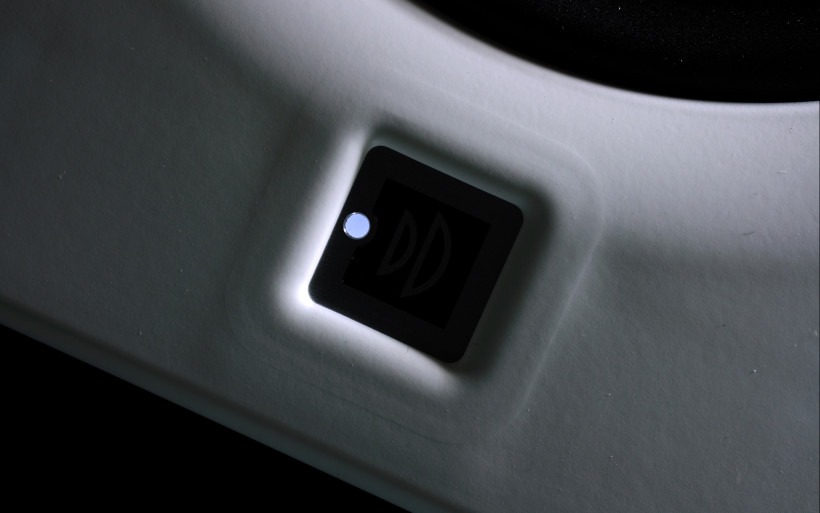 Long story’s short, neither was Grimm Audio interested in having its goods visible here nor Kii Audio and perhaps one day this will change, yet my investigative hunger remained the very same. Europe’s industrial center – Netherlands – is the home for many more hi-tech audio operations and i.e. Aequo Audio comes to mind. Nonetheless, the goal was to move along the lines of Kii Audio Three, thus a standalone affair with minimal demands. After quick research yet another company stirring the same pot and from the same country was discovered. Dutch & Dutch is currently 10+ people strong and based in Rotterdam. This manufacture was established by a group of five individuals of different specialties. Long before this review’s hero emerged, under the Pro Fidelity banner they handled R&D for third parties, were associated with the pro industry and responsible for providing particular audio hardware suitable for various music venues and nightclubs. Picture proprietary speaker systems capable of direct sound propagation across the whole audible range, object-based virtual sound controlled in different room areas and DSP very much involved. At some point, clearly impressed sound engineers on Disney’s payroll asked the Dutch crew about a product similarly potent yet also feasible in their studio work and domesticated. That’s how Dutch & Dutch 8c came to be.
Long story’s short, neither was Grimm Audio interested in having its goods visible here nor Kii Audio and perhaps one day this will change, yet my investigative hunger remained the very same. Europe’s industrial center – Netherlands – is the home for many more hi-tech audio operations and i.e. Aequo Audio comes to mind. Nonetheless, the goal was to move along the lines of Kii Audio Three, thus a standalone affair with minimal demands. After quick research yet another company stirring the same pot and from the same country was discovered. Dutch & Dutch is currently 10+ people strong and based in Rotterdam. This manufacture was established by a group of five individuals of different specialties. Long before this review’s hero emerged, under the Pro Fidelity banner they handled R&D for third parties, were associated with the pro industry and responsible for providing particular audio hardware suitable for various music venues and nightclubs. Picture proprietary speaker systems capable of direct sound propagation across the whole audible range, object-based virtual sound controlled in different room areas and DSP very much involved. At some point, clearly impressed sound engineers on Disney’s payroll asked the Dutch crew about a product similarly potent yet also feasible in their studio work and domesticated. That’s how Dutch & Dutch 8c came to be.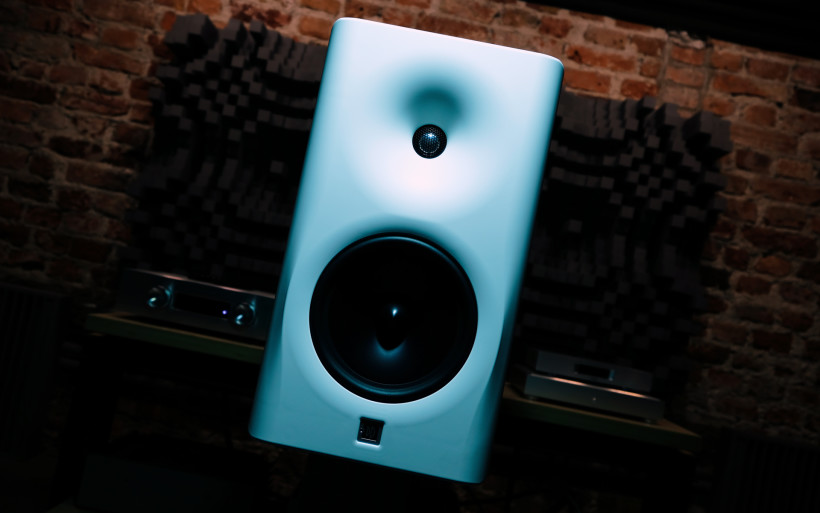 My contact was Martijn Mensik. At first I thought that he’s the well-trained Dutch & Dutch PR man as prompt replies to every technical question I had he delivered in a jiffy. Still, he seemed to be a wee bit too much in the know to turn out at some point as this company’s acoustic engineer and one of its five co-owners. All in all, Martijn was a spot on person to handle yours truly, that’s for sure. The man explained that he grew fond of open baffle products, has built a number of these in the past, wanted to exploit some of this topology’s virtues without its usual drawbacks and was fortunate to find people after the same goals and then some. Additional inspiration came from Floyd Toole’s work and Grimm Audio’s grand product mentioned up above. It took 7 years for Dutch & Dutch 8c to arrive, its ‘c’ letter stands for ‘cardioid’ and the company’s name indicates that both design and components behind this unusual product are Dutch.
My contact was Martijn Mensik. At first I thought that he’s the well-trained Dutch & Dutch PR man as prompt replies to every technical question I had he delivered in a jiffy. Still, he seemed to be a wee bit too much in the know to turn out at some point as this company’s acoustic engineer and one of its five co-owners. All in all, Martijn was a spot on person to handle yours truly, that’s for sure. The man explained that he grew fond of open baffle products, has built a number of these in the past, wanted to exploit some of this topology’s virtues without its usual drawbacks and was fortunate to find people after the same goals and then some. Additional inspiration came from Floyd Toole’s work and Grimm Audio’s grand product mentioned up above. It took 7 years for Dutch & Dutch 8c to arrive, its ‘c’ letter stands for ‘cardioid’ and the company’s name indicates that both design and components behind this unusual product are Dutch.
Build
Dutch & Dutch 8c might look like a mainstream affair on the surface, but in reality it’s not. After getting familiar with all its features it’s understandable why it took years of extensive R&D. The Dutch team’s goal was to deliver an all-in-one product as compact as possible, yet sound wise capable of behaving itself in every environment as equally potently. In order to develop one such item, the crew defined several key principles and moved from there. Among flat frequency response, tonal neutrality, full bandwidth, cabinet’s resonances and stored energy reduced, similar on- and off-axis response, uni-directional and cardioid radiation patterns, many more were addressed. If this doesn’t ring any bells, let me simplify by saying that all these measures were taken to provide a listener with sound as uncoloured, precise and universal as possible, but also highly environment acoustics independent. Put shortly, it all comes down to balance, hearing the product itself directly and having its reflections and in-room interaction respectively reduced and controlled. Needless to say, the Dutch team set themselves on quite the task to accomplish.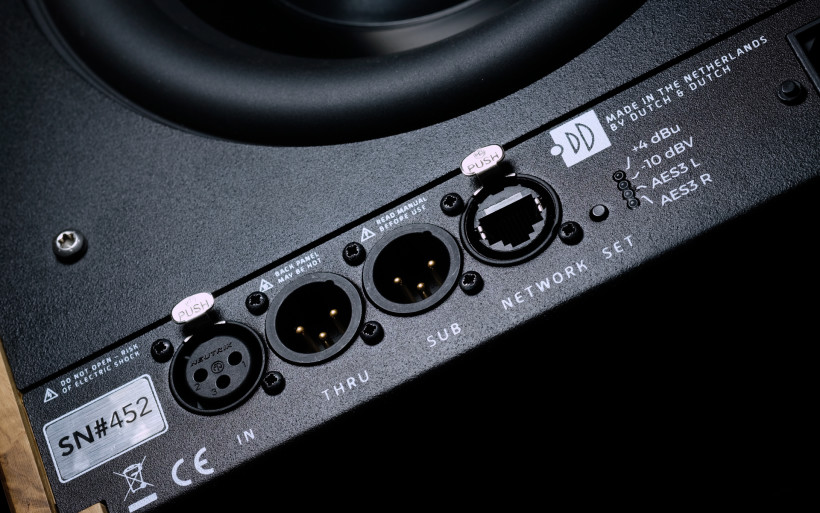 Dutch & Dutch 8c arrived in two separate cardboards married to a wooden tray via foil and strong tape. The package was perfectly secured and each box filled with foam forms consisted of three elements; base, surrounding walls and top cover. In order to extract each speaker from its housing, these pieces had to be removed one by one to be left with just the one underneath the product. I’ve found this packaging scheme very clever and a breeze to handle. Each box also carried one regular power cord, unusually long LAN cable and woolen gloves. One female XLR plug loaded with a resistor was also found inside the cargo and we’ll investigate its purpose in a bit.
Dutch & Dutch 8c arrived in two separate cardboards married to a wooden tray via foil and strong tape. The package was perfectly secured and each box filled with foam forms consisted of three elements; base, surrounding walls and top cover. In order to extract each speaker from its housing, these pieces had to be removed one by one to be left with just the one underneath the product. I’ve found this packaging scheme very clever and a breeze to handle. Each box also carried one regular power cord, unusually long LAN cable and woolen gloves. One female XLR plug loaded with a resistor was also found inside the cargo and we’ll investigate its purpose in a bit.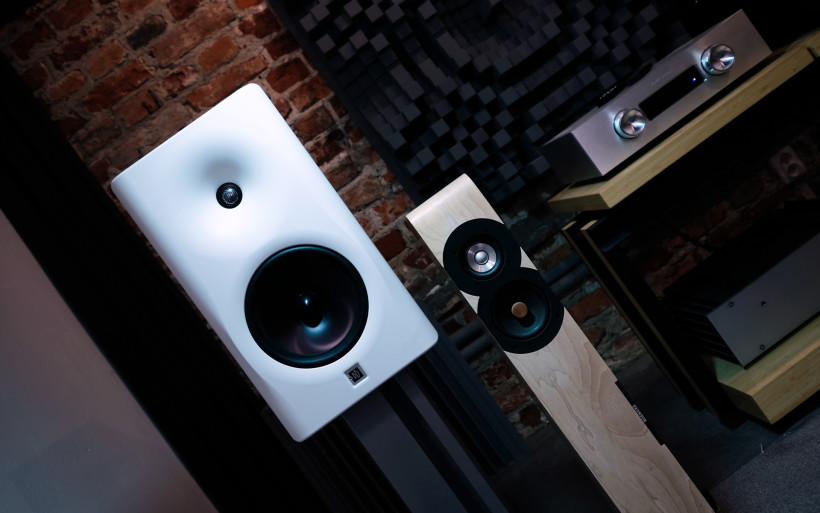 Dutch & Dutch 8c is a compact fully active 3-way affair. Each speaker measures 485x270x380mm and weighs hefty 26 kilograms. Cabinets are made of 19mm thick solid oaken panels located on top and sides, injection-molded ABS serves as the front, 18mm birch ply walls are strategically placed inside and one bent sheet metal plate covers bottom and rear surfaces. The product is slightly rounded, assembled with attention to details and – even though it might look regularly – it’ obvious where all the money went. Subjectively speaking, the 8c’s looks grew on me immensely also due to its performance. Free from visual flash, not oversized and very much domestic, I’m sure it’ll be a nice addition to many living rooms.
Dutch & Dutch 8c is a compact fully active 3-way affair. Each speaker measures 485x270x380mm and weighs hefty 26 kilograms. Cabinets are made of 19mm thick solid oaken panels located on top and sides, injection-molded ABS serves as the front, 18mm birch ply walls are strategically placed inside and one bent sheet metal plate covers bottom and rear surfaces. The product is slightly rounded, assembled with attention to details and – even though it might look regularly – it’ obvious where all the money went. Subjectively speaking, the 8c’s looks grew on me immensely also due to its performance. Free from visual flash, not oversized and very much domestic, I’m sure it’ll be a nice addition to many living rooms.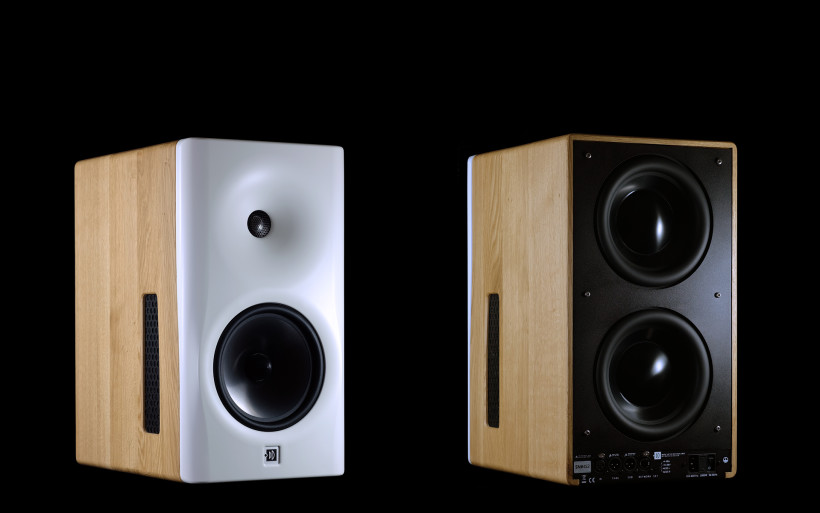 Crossed in at 1’250Hz via 4-th order Linkwitz-Riley slope, 1” aluminium/magnesium dome tweeter by Seas is married to a custom waveguide and one 8” aluminium-coned midrange transducer sits a bit below. The latter occupies its own chamber unusually vented on both sides via narrow yet tall and slightly curved openings. This driver’s back waves escape through these into a room and are cancelled in the process to have their interactions with adjacent walls limited. Only its front radiation reaches our ears to form heart-shaped dispersion pattern aka cardioid. Moving on, two 8” long throw woofers found on each cabinet’s rear also sport aluminium cones and share their own sealed housing. Martijn informed me that in order to get the best sonic effects, both speakers have to be placed within 10-40cm distance to front wall. When the product is coupled with this surface like so, it becomes its extension and enhanced LF crack is the upshot.
Crossed in at 1’250Hz via 4-th order Linkwitz-Riley slope, 1” aluminium/magnesium dome tweeter by Seas is married to a custom waveguide and one 8” aluminium-coned midrange transducer sits a bit below. The latter occupies its own chamber unusually vented on both sides via narrow yet tall and slightly curved openings. This driver’s back waves escape through these into a room and are cancelled in the process to have their interactions with adjacent walls limited. Only its front radiation reaches our ears to form heart-shaped dispersion pattern aka cardioid. Moving on, two 8” long throw woofers found on each cabinet’s rear also sport aluminium cones and share their own sealed housing. Martijn informed me that in order to get the best sonic effects, both speakers have to be placed within 10-40cm distance to front wall. When the product is coupled with this surface like so, it becomes its extension and enhanced LF crack is the upshot.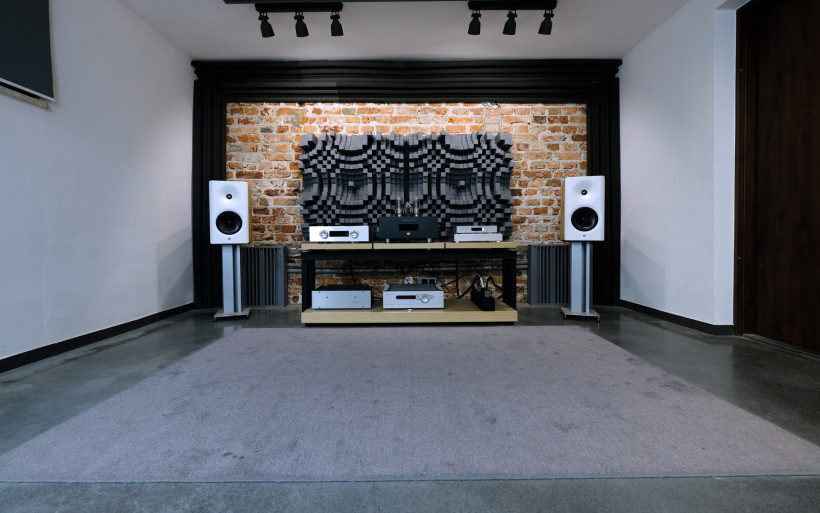 Interesting, isn’t it? The 8c’s midrange transducers cardioid in order to prevent their interaction with front wall and back-firing bass drivers cleverly exploiting this exact surface for extra downstairs kick reminded me of what i.e. Jorma Salmi (1948-2018) did. His still manufactured Gradient Helsinki 1.5 is a cardioid affair too, whereas the same company’s Six model I reviewed years back (then known as 6.0) interacted at my place very similarly to the 8c. When decoupled from a wall, the latter’s passive membranes located very low on its rear were almost silent. But shortening this distance to some 20cm or so netted truly powerful downstairs slam. In my book that’s clever, but the important bit is that the Finnish engineer designed his products to be as acoustically and visually room independent as possible and the Dutch crew followed the same path with their 8c.
Interesting, isn’t it? The 8c’s midrange transducers cardioid in order to prevent their interaction with front wall and back-firing bass drivers cleverly exploiting this exact surface for extra downstairs kick reminded me of what i.e. Jorma Salmi (1948-2018) did. His still manufactured Gradient Helsinki 1.5 is a cardioid affair too, whereas the same company’s Six model I reviewed years back (then known as 6.0) interacted at my place very similarly to the 8c. When decoupled from a wall, the latter’s passive membranes located very low on its rear were almost silent. But shortening this distance to some 20cm or so netted truly powerful downstairs slam. In my book that’s clever, but the important bit is that the Finnish engineer designed his products to be as acoustically and visually room independent as possible and the Dutch crew followed the same path with their 8c.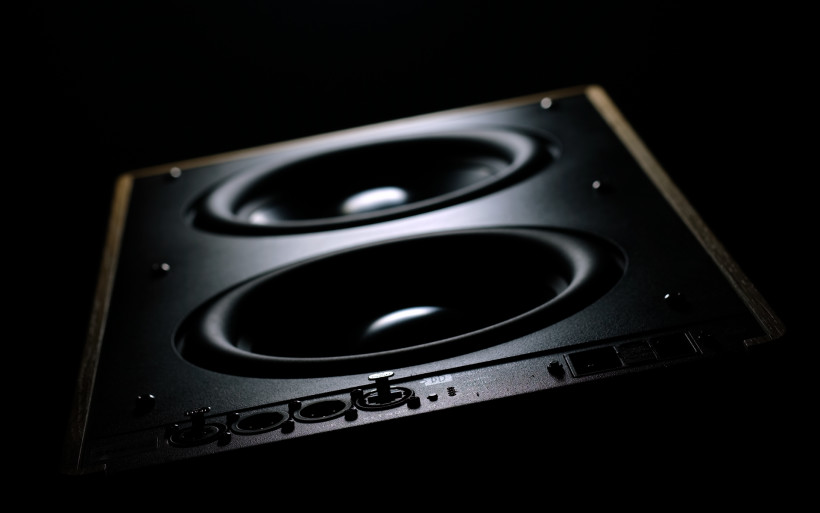 Each cabinet’s front a bit below midrange section sports the manufacturer’s logo and a LED, which can be lit up, dimmed down completely or blinking to inform one about the product’s status. Each enclosure’s bottom has several rubber feet and a small intake vent with a petite soundless fan to cool internal electronics if needed. This opening shouldn’t be blocked as the 8c’s inside is packed with hardware. Rated at 250w each, separate Pascal Audio S-PRO2 Class D amps handle tweeters and midrange drivers, whereas a single 500w module of the same topology amplifies both woofers. Texas Instruments PCM4104 and PCM4202 handle D/A and A/D conversion respectively, whereas the DSP core of choice is fully programmable ADAU1452 by Analog Devices. It still has some computing power reserves to incorporate additional features to the product and that’s something Martijn and his team have been working on since their 8c project’s early days.
Each cabinet’s front a bit below midrange section sports the manufacturer’s logo and a LED, which can be lit up, dimmed down completely or blinking to inform one about the product’s status. Each enclosure’s bottom has several rubber feet and a small intake vent with a petite soundless fan to cool internal electronics if needed. This opening shouldn’t be blocked as the 8c’s inside is packed with hardware. Rated at 250w each, separate Pascal Audio S-PRO2 Class D amps handle tweeters and midrange drivers, whereas a single 500w module of the same topology amplifies both woofers. Texas Instruments PCM4104 and PCM4202 handle D/A and A/D conversion respectively, whereas the DSP core of choice is fully programmable ADAU1452 by Analog Devices. It still has some computing power reserves to incorporate additional features to the product and that’s something Martijn and his team have been working on since their 8c project’s early days.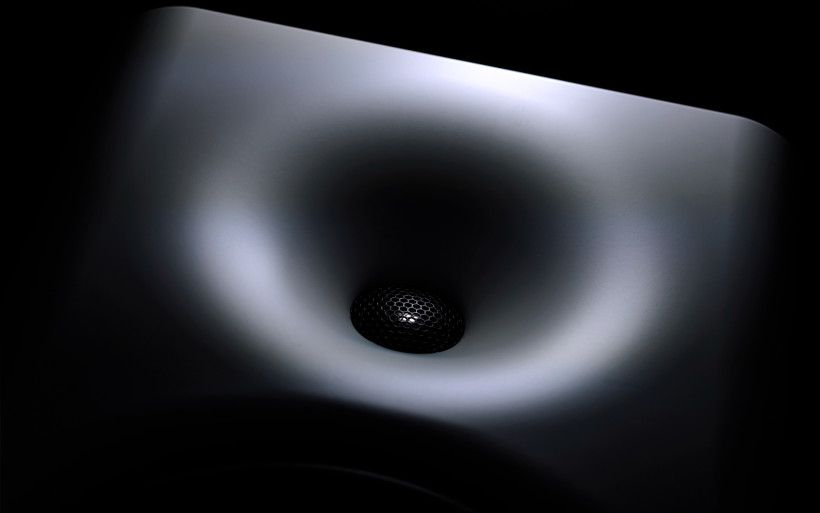 Several connections are located on each speaker’s rear, just above its bottom ledge. The female XLR socket on the far left is digital AES3 input (also serves as analog input if set like so), then there’s male XLR thruput for digital signal and yet another one of the same sort to incorporate a separate sub. Next in line is one RJ45 socket and a small input selection button which allows one to cycle through several LEDs with available options listed (+4dBu, -10dBu, AES3 L, AES3 R, AES-mono and not yet operational streaming) next to these diodes. One IEC socket with self-replaceable fuse and on/off switch per enclosure close the list.
Several connections are located on each speaker’s rear, just above its bottom ledge. The female XLR socket on the far left is digital AES3 input (also serves as analog input if set like so), then there’s male XLR thruput for digital signal and yet another one of the same sort to incorporate a separate sub. Next in line is one RJ45 socket and a small input selection button which allows one to cycle through several LEDs with available options listed (+4dBu, -10dBu, AES3 L, AES3 R, AES-mono and not yet operational streaming) next to these diodes. One IEC socket with self-replaceable fuse and on/off switch per enclosure close the list.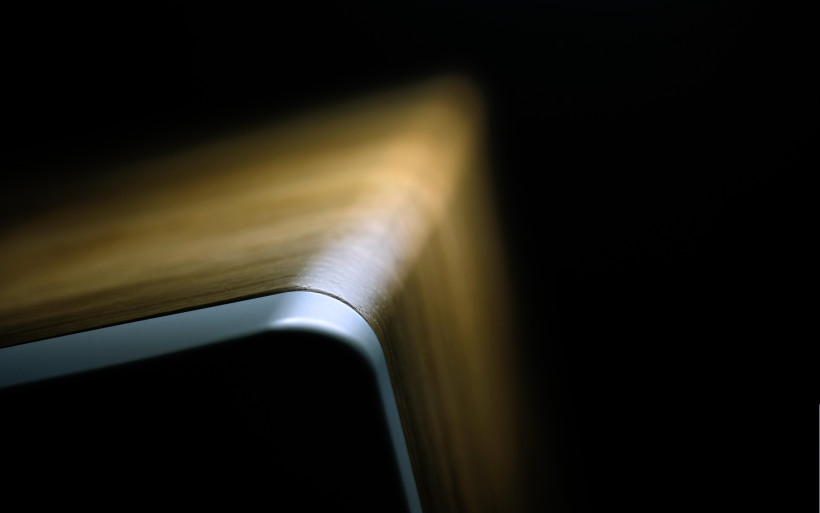 In order to set up the 8c as the manufacturer suggested, several things had to be done. Each speaker was powered from my strip and then independently connected to a router. Next I had to figure out a way how to send data to one of two boxes and here my trusty Hydra-X+ S/PDIF interface by Audiobyte proved to be useful. I could send digital stream to this device via USB, then pass it along via XLR cable to the left speaker’s AES3 input, then via adjacent thruput socket and several meters long BNC cable I finally got to the other cabinet’s AES3 in. To close the digital loop, I had to use that standalone XLR plug loaded with one resistor on the second speaker’s thruput. Without this addition there was no sound in one channel. Telling both boxes which one’s which via AES3 L and AES3 R selections for channels left and right respectively was the last thing to do. Once all was sorted, I could finally grab a seat, connect my laptop to the same network the two 8c monitors were married to and dig into options. Since each speaker had suitable software installed, typing http://8c-xxx (the ‘xxx’ part stood for the product’s serial numbers) was all it took to see a very simple yet friendly user interface. From there I could turn both front LEDs on and off, do volume adjustments, apply filters i.e. to reduce standing waves and set distance to adjacent walls for each monitor. A breeze, eh?
In order to set up the 8c as the manufacturer suggested, several things had to be done. Each speaker was powered from my strip and then independently connected to a router. Next I had to figure out a way how to send data to one of two boxes and here my trusty Hydra-X+ S/PDIF interface by Audiobyte proved to be useful. I could send digital stream to this device via USB, then pass it along via XLR cable to the left speaker’s AES3 input, then via adjacent thruput socket and several meters long BNC cable I finally got to the other cabinet’s AES3 in. To close the digital loop, I had to use that standalone XLR plug loaded with one resistor on the second speaker’s thruput. Without this addition there was no sound in one channel. Telling both boxes which one’s which via AES3 L and AES3 R selections for channels left and right respectively was the last thing to do. Once all was sorted, I could finally grab a seat, connect my laptop to the same network the two 8c monitors were married to and dig into options. Since each speaker had suitable software installed, typing http://8c-xxx (the ‘xxx’ part stood for the product’s serial numbers) was all it took to see a very simple yet friendly user interface. From there I could turn both front LEDs on and off, do volume adjustments, apply filters i.e. to reduce standing waves and set distance to adjacent walls for each monitor. A breeze, eh? 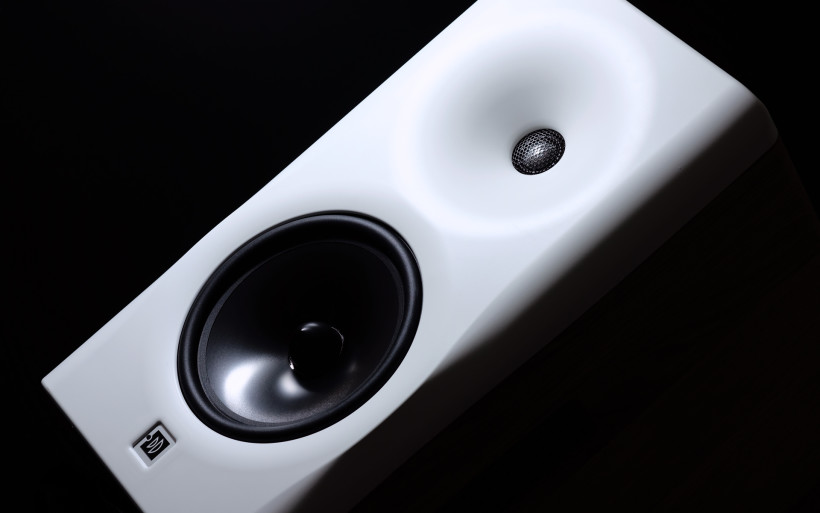 Dutch & Dutch 8c is a bit tricky. A number of rather long cables it exploited netted a rather messy look, but this was no deal-breaker. More importantly, without my S/PDIF interface, the 8c as a stand-alone solution wouldn’t have happened. Several weeks later Lumin U1 Mini transport arrived and in effect both my Hydra-X+ and laptop were no longer needed. But my point is that one has to have a way to pass data from a transport of choice to the 8c via digital XLR. Since for now there’s no way around this matter, it needs to be taken into account in order to avoid frustration. This begged the question about lack of USB input. Helpful as always, Martijn informed me that Dutch & Dutch believes in music over IP. That’s the future according to them and highly likely they’re right. The man explained that their DSP is nowhere near to be maxed, talks with several third parties are on and the company’s R&D team is on the case. Perhaps soon we’ll see additional functions which might render XLR cables completely useless to have a pair of power cords and RJ45 cables needed, but for now it is what it is.
Dutch & Dutch 8c is a bit tricky. A number of rather long cables it exploited netted a rather messy look, but this was no deal-breaker. More importantly, without my S/PDIF interface, the 8c as a stand-alone solution wouldn’t have happened. Several weeks later Lumin U1 Mini transport arrived and in effect both my Hydra-X+ and laptop were no longer needed. But my point is that one has to have a way to pass data from a transport of choice to the 8c via digital XLR. Since for now there’s no way around this matter, it needs to be taken into account in order to avoid frustration. This begged the question about lack of USB input. Helpful as always, Martijn informed me that Dutch & Dutch believes in music over IP. That’s the future according to them and highly likely they’re right. The man explained that their DSP is nowhere near to be maxed, talks with several third parties are on and the company’s R&D team is on the case. Perhaps soon we’ll see additional functions which might render XLR cables completely useless to have a pair of power cords and RJ45 cables needed, but for now it is what it is.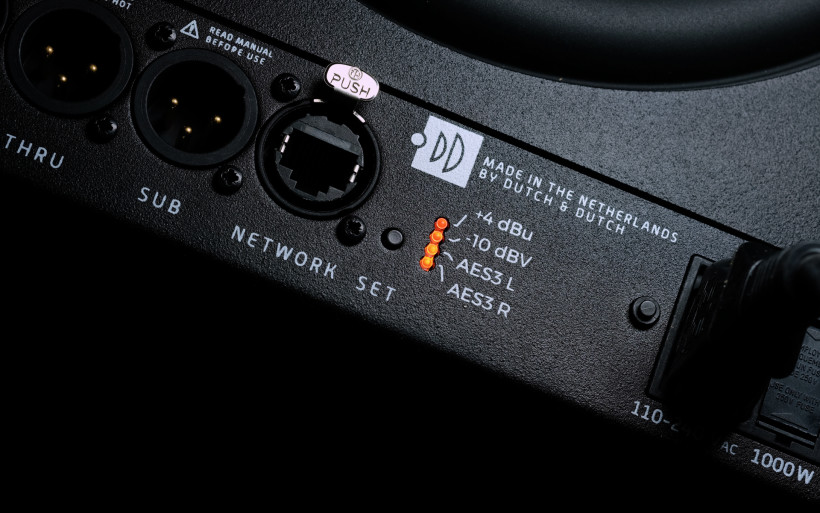 Moving on, Dutch & Dutch 8c was designed to be an enclosed system and that’s the optimal usage scenario. No amps, no DACs, no preamps, no rack full of hardware. That’s why it might not be ideal for individuals into mix’n’matching, even though it can be fronted via a separate DAC and preamp. Nonetheless, for a reason this didn’t work as planned in my case, the Dutch I see as a wholesome high quality do-it-all audio affair in the first place and everyone interested in this product I strongly encourage to share the view. After getting familiar with everything above, many purists would cringe now: “All-in-one package? DSP? No wiggle room? What evil mainstream sorcery is this?!?”. If the 8c is not your cup of tea by principle, please move on. But if you’re up for what’s next, to fasten your seatbelt is my sincere advice. It’s going to be a helluva ride.
Moving on, Dutch & Dutch 8c was designed to be an enclosed system and that’s the optimal usage scenario. No amps, no DACs, no preamps, no rack full of hardware. That’s why it might not be ideal for individuals into mix’n’matching, even though it can be fronted via a separate DAC and preamp. Nonetheless, for a reason this didn’t work as planned in my case, the Dutch I see as a wholesome high quality do-it-all audio affair in the first place and everyone interested in this product I strongly encourage to share the view. After getting familiar with everything above, many purists would cringe now: “All-in-one package? DSP? No wiggle room? What evil mainstream sorcery is this?!?”. If the 8c is not your cup of tea by principle, please move on. But if you’re up for what’s next, to fasten your seatbelt is my sincere advice. It’s going to be a helluva ride.
Sound
In order to review Dutch & Dutch 8c, my regular setup was almost entirely ditched early on. This review’s hero simply didn’t need it. Martijn informed me that the ideal 8c scenario would only involve a transport capable of sending data via AES/EBU to the product directly and that was my goal. Here Audiobyte’s battery based Hydra-X+ S/PDIF interface came into play to serve as a bridge between my laptop and the 8c. The setup assembled like so exploited software based volume control. Although far from optimal, it proved to be a good starting point nonetheless. Luckily this year’s local Audio Video Show yours truly left with Lumin U1 Mini, which helped a lot in understanding how much of an impact such a transport had on the 8c. And just to ease my curiosity, LampizatOr Pacific fed iFi audio’s Pro iCAN on duty as a handy preamplifier. Both speakers were connected to Gigawatt PF-2 power strip via LessLoss C-MARC power cords. Each 8c was placed at around 40cm distance to front and side walls, just as the doctor ordered.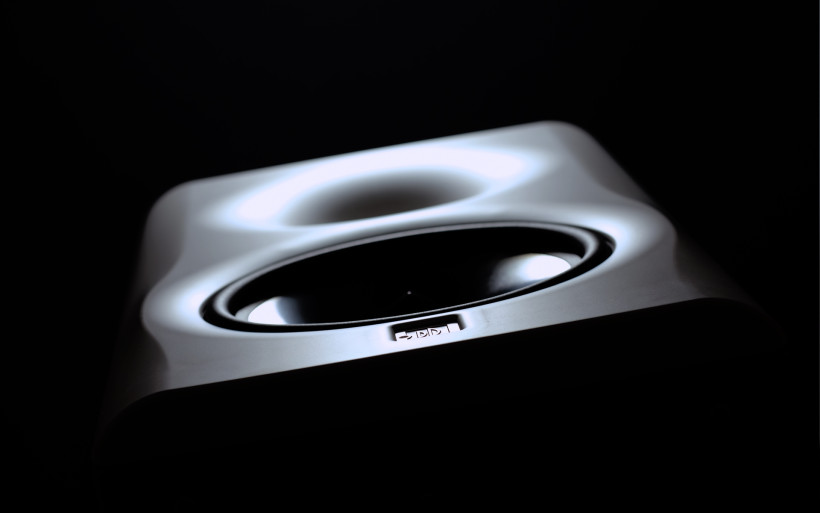 Let’s move several stereotypes out of the way first, this time around it really is unavoidable. Many people would label Dutch & Dutch 8c as a monitor meant to do a specific recording/mixing job above all else. Even its on-site description gives more than one reason to think so and many technical solutions it exploits additionally fuel the same fire. Fully active package loaded with XLRs exclusively, class D amps, DSP, aluminium cones and tuned to be utmost neutral and even can be safely considered as a sound engineer’s wet dream. Such goods are oftentimes said to be truthful yet lifeless and boring tools designed to be used as just that. Fair enough, many items of similar breed behave like so and Dutch & Dutch 8c is no exception. It’s safe to say as early as now that many professionals would’ve found this one very useful in their work, that I’m sure of. But the insightful Dutch also gives a big middle finger to the ‘lifeless and boring’ part in truly spectacular fashion. At my place it pulled stunts beyond reach of vast majority of floorstanders and monitors known to me and was exceptionally easygoing while doing so.
Let’s move several stereotypes out of the way first, this time around it really is unavoidable. Many people would label Dutch & Dutch 8c as a monitor meant to do a specific recording/mixing job above all else. Even its on-site description gives more than one reason to think so and many technical solutions it exploits additionally fuel the same fire. Fully active package loaded with XLRs exclusively, class D amps, DSP, aluminium cones and tuned to be utmost neutral and even can be safely considered as a sound engineer’s wet dream. Such goods are oftentimes said to be truthful yet lifeless and boring tools designed to be used as just that. Fair enough, many items of similar breed behave like so and Dutch & Dutch 8c is no exception. It’s safe to say as early as now that many professionals would’ve found this one very useful in their work, that I’m sure of. But the insightful Dutch also gives a big middle finger to the ‘lifeless and boring’ part in truly spectacular fashion. At my place it pulled stunts beyond reach of vast majority of floorstanders and monitors known to me and was exceptionally easygoing while doing so. Dutch & Dutch 8c didn’t hide with its sound characteristic, not at all. In an instant its pinpoint accuracy, clarity and tonal evenness were heard and the longer I familiarized with it, the more I understood that such natural voicing this was one of its designers’ key goals indeed. After several weeks spent with this charmer, my take on it didn’t change a bit on these counts, though things got additionally spiced up by avoidance of the overly analytical and dry trap oftentimes associated with flavouring of this sort. The 8c delivered the full care package. Not only it was tuned very much naturally hence sound wise universally and safely, but also showcased things as they were and was pleasantly moist on top of that. This set of virtues gave a way to think that the Dutch brought to the table perfectly balanced cards. Neither it sounded barren and emotionally uninviting, nor overly lit up, sharp, glassy, piercing or skinny, let alone excessive gravitas or warmth. As long as quality repertoire was on, the outcome was as even and honest as it could to my ears, whereas insight the Dutch provided I thoroughly enjoyed. After weeks of rediscovering my music I couldn’t find one catch. Not even once the 8c turned out to be the culprit, on the contrary to my music library. The usually unlistenable things remained as such, whereas top notch material graced me with nothing short but joy. After several days of extensive auditions, such an arrangement seemed very much fair. As long as I did my part, the Dutch loaner followed accordingly. But there was more.
Dutch & Dutch 8c didn’t hide with its sound characteristic, not at all. In an instant its pinpoint accuracy, clarity and tonal evenness were heard and the longer I familiarized with it, the more I understood that such natural voicing this was one of its designers’ key goals indeed. After several weeks spent with this charmer, my take on it didn’t change a bit on these counts, though things got additionally spiced up by avoidance of the overly analytical and dry trap oftentimes associated with flavouring of this sort. The 8c delivered the full care package. Not only it was tuned very much naturally hence sound wise universally and safely, but also showcased things as they were and was pleasantly moist on top of that. This set of virtues gave a way to think that the Dutch brought to the table perfectly balanced cards. Neither it sounded barren and emotionally uninviting, nor overly lit up, sharp, glassy, piercing or skinny, let alone excessive gravitas or warmth. As long as quality repertoire was on, the outcome was as even and honest as it could to my ears, whereas insight the Dutch provided I thoroughly enjoyed. After weeks of rediscovering my music I couldn’t find one catch. Not even once the 8c turned out to be the culprit, on the contrary to my music library. The usually unlistenable things remained as such, whereas top notch material graced me with nothing short but joy. After several days of extensive auditions, such an arrangement seemed very much fair. As long as I did my part, the Dutch loaner followed accordingly. But there was more.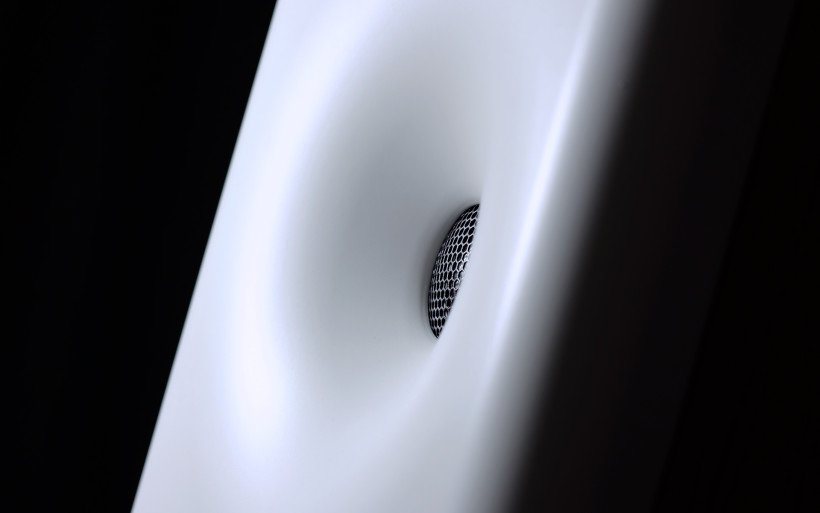 Neither the 8c overused its magnifying potential nor made the outcome prettier than it originally was, thus many individuals very much into listening to their music collection unaltered would surely find its tuning pretty much perfect. This feature all by itself indicated that the team behind this product efficiently handled all patterns associated with aluminium cones and class D. Their creation didn’t sport any hints of metallic tint which oftentimes comes as a part of tuning like so, on the contrary to pleasant moisture and smoothness. There you have it, yet another stereotype just went under. The loaner didn’t play on my emotions via euphonic sensation i.e. properly amplified full-range transducers are known for. But it involved me by playing fair, balanced and refined game without cutting a single corner and delivered on all counts. This proved me that the Dutch crew is a happy bunch of heavyweight aficionados after music showcased as is, yet also served in refined and pleasant fashion. I’m also positive that many enthusiasts rolling daily with harmonically richer hardware would eventually find the 8c very much inviting and impressive because of such honest, uncoloured and artfully seasoned voicing.
Neither the 8c overused its magnifying potential nor made the outcome prettier than it originally was, thus many individuals very much into listening to their music collection unaltered would surely find its tuning pretty much perfect. This feature all by itself indicated that the team behind this product efficiently handled all patterns associated with aluminium cones and class D. Their creation didn’t sport any hints of metallic tint which oftentimes comes as a part of tuning like so, on the contrary to pleasant moisture and smoothness. There you have it, yet another stereotype just went under. The loaner didn’t play on my emotions via euphonic sensation i.e. properly amplified full-range transducers are known for. But it involved me by playing fair, balanced and refined game without cutting a single corner and delivered on all counts. This proved me that the Dutch crew is a happy bunch of heavyweight aficionados after music showcased as is, yet also served in refined and pleasant fashion. I’m also positive that many enthusiasts rolling daily with harmonically richer hardware would eventually find the 8c very much inviting and impressive because of such honest, uncoloured and artfully seasoned voicing. If the confession up above doesn’t indicate anything out of ordinary, the 8c’s downstairs department should drastically change this status quo. The product sounded exceptionally potently on this count in particular. The most shocking thing was how deep down it went. Gloss Drop LP by Battles is loaded with artificially generated very low and feisty bass, which most speakers deliver as an additive to everything else. The 8c the same range morphed it into something very much sensible; not only audible but felt inside my chest. That’s how truly deep low FR works. Somewhat similar to a subtle massage, lowest octaves interact not only with our ears but bodies too and the Dutch showed this exactly with no hesitation. Such a rare yet utmost beneficial addition can flip a hidden switch and change the way one perceives music. Shortly past getting back to my daily driver, in an instant I’ve noticed that something very much important was missing.
If the confession up above doesn’t indicate anything out of ordinary, the 8c’s downstairs department should drastically change this status quo. The product sounded exceptionally potently on this count in particular. The most shocking thing was how deep down it went. Gloss Drop LP by Battles is loaded with artificially generated very low and feisty bass, which most speakers deliver as an additive to everything else. The 8c the same range morphed it into something very much sensible; not only audible but felt inside my chest. That’s how truly deep low FR works. Somewhat similar to a subtle massage, lowest octaves interact not only with our ears but bodies too and the Dutch showed this exactly with no hesitation. Such a rare yet utmost beneficial addition can flip a hidden switch and change the way one perceives music. Shortly past getting back to my daily driver, in an instant I’ve noticed that something very much important was missing.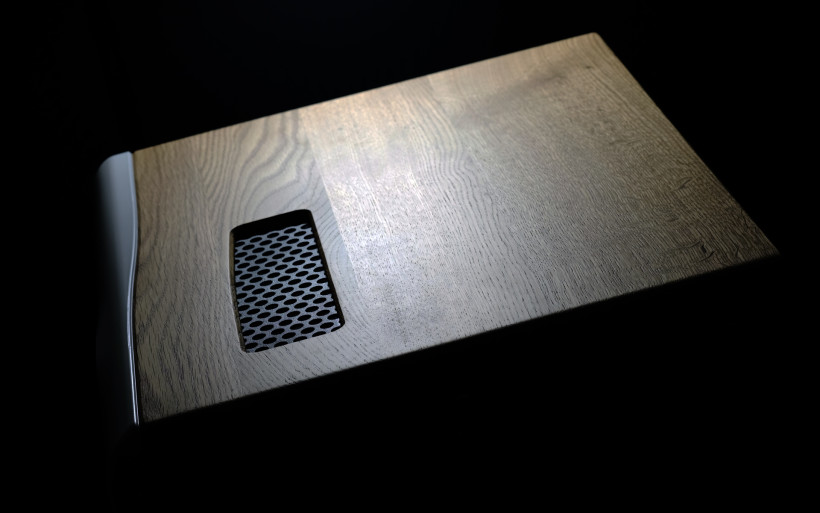 The 8c’s utterly impressive downstairs reach wasn’t the only admirable thing about them. The whole low range was fabulously developed yet not overdone in any way. Showcased in utmost effortless and perfectly controlled fashion, it reminded me of what open baffles are known for. The Dutch sensation was quite similar, though I’ve never heard any OB affair capable of singing this low at my place, perhaps with one exception of far costlier Reflector Audio Bespoke P15 floorstanders reviewed a good while ago. Not only the 8c acted like a far bigger and bolder speaker than it was, but also didn’t show any signs of struggle or fatigue at that. Picture a petite yet very well-trained athlete capable of handling marathonian distances without breaking a single drop of sweat. That’s this report’s hero in a nutshell.
The 8c’s utterly impressive downstairs reach wasn’t the only admirable thing about them. The whole low range was fabulously developed yet not overdone in any way. Showcased in utmost effortless and perfectly controlled fashion, it reminded me of what open baffles are known for. The Dutch sensation was quite similar, though I’ve never heard any OB affair capable of singing this low at my place, perhaps with one exception of far costlier Reflector Audio Bespoke P15 floorstanders reviewed a good while ago. Not only the 8c acted like a far bigger and bolder speaker than it was, but also didn’t show any signs of struggle or fatigue at that. Picture a petite yet very well-trained athlete capable of handling marathonian distances without breaking a single drop of sweat. That’s this report’s hero in a nutshell.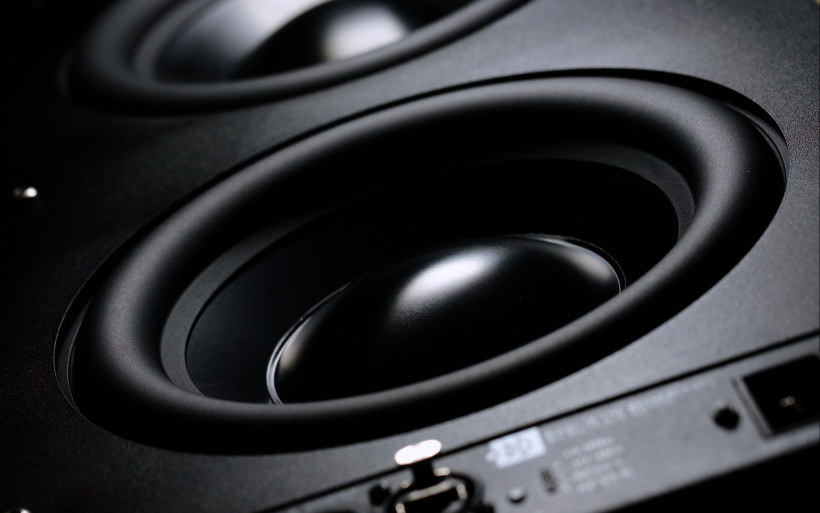 The Dutch sported very voluminous set of fully developed lungs, which readily shook the whole place with no restrictions at all. If truly low frequencies were a part of a given recording, the outcome was nothing short but massive to make my room not wobbly but positively alive. I’ve never heard ambience roar this present within my fairly small journalistic environment and bass grasped this tightly at the same time. The 8c had its whole downstairs realm in perfect check, not even a hint of boom it sported and preserved a fabulous contour-to-moisture ratio. On this count OBs usually fall a bit short to be viewed as a tad dry at times, yet this writing’s star didn’t. Amazing.
The Dutch sported very voluminous set of fully developed lungs, which readily shook the whole place with no restrictions at all. If truly low frequencies were a part of a given recording, the outcome was nothing short but massive to make my room not wobbly but positively alive. I’ve never heard ambience roar this present within my fairly small journalistic environment and bass grasped this tightly at the same time. The 8c had its whole downstairs realm in perfect check, not even a hint of boom it sported and preserved a fabulous contour-to-moisture ratio. On this count OBs usually fall a bit short to be viewed as a tad dry at times, yet this writing’s star didn’t. Amazing.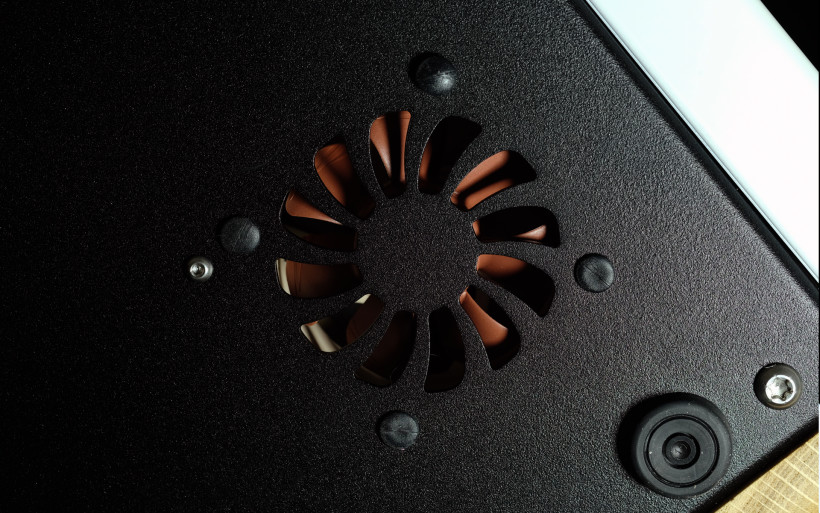 The 8c’s textural generosity and overall vividness mixed with exceptionally snappy attitude, slam, overall heft, very much sensible punch and stupendous reach netted not only a spot on bass balance but unforgettable experience in general. The effect led a true ear-opening and addictive show which had everything to keep me in the hot seat for hours. All things considered, the Dutch pulled off probably the second best or the very best downstairs performance I’ve heard at my place thus far. Truth told, I wasn’t aware that such a spectacular outcome also free from any issues typical in my room was even possible. And speaking of troublesome acoustics, well-equipped Martijn visited me the day after the Polish Audio Video Show ended. Past several measurements he then blasted my place with constant low FR just to show me how this space sounded like; where was I safe and where standing waves lived. The effect of Martijn’s work were mapped spikes at 30 and 60Hz and one dip at 45Hz. Other than that, he concluded that my HQ was fine, it served midrange and highs evenly. Then after auditioning the 8c for an hour or so I was informed that the room actually sounded better than its measurements suggested. This story was told for a reason though. Before Martijn’s visitation, the 8c was on the job for some three weeks or so and I’ve found it space wise very independent and perfectly orderly. But after some minor EQ tweaks the man did, his 8c’s performance improved a lot, which reminded me yet again how important room acoustics are. If mild DSP involvement is the price to pay for substantial quality leap on this count, so be it.
The 8c’s textural generosity and overall vividness mixed with exceptionally snappy attitude, slam, overall heft, very much sensible punch and stupendous reach netted not only a spot on bass balance but unforgettable experience in general. The effect led a true ear-opening and addictive show which had everything to keep me in the hot seat for hours. All things considered, the Dutch pulled off probably the second best or the very best downstairs performance I’ve heard at my place thus far. Truth told, I wasn’t aware that such a spectacular outcome also free from any issues typical in my room was even possible. And speaking of troublesome acoustics, well-equipped Martijn visited me the day after the Polish Audio Video Show ended. Past several measurements he then blasted my place with constant low FR just to show me how this space sounded like; where was I safe and where standing waves lived. The effect of Martijn’s work were mapped spikes at 30 and 60Hz and one dip at 45Hz. Other than that, he concluded that my HQ was fine, it served midrange and highs evenly. Then after auditioning the 8c for an hour or so I was informed that the room actually sounded better than its measurements suggested. This story was told for a reason though. Before Martijn’s visitation, the 8c was on the job for some three weeks or so and I’ve found it space wise very independent and perfectly orderly. But after some minor EQ tweaks the man did, his 8c’s performance improved a lot, which reminded me yet again how important room acoustics are. If mild DSP involvement is the price to pay for substantial quality leap on this count, so be it.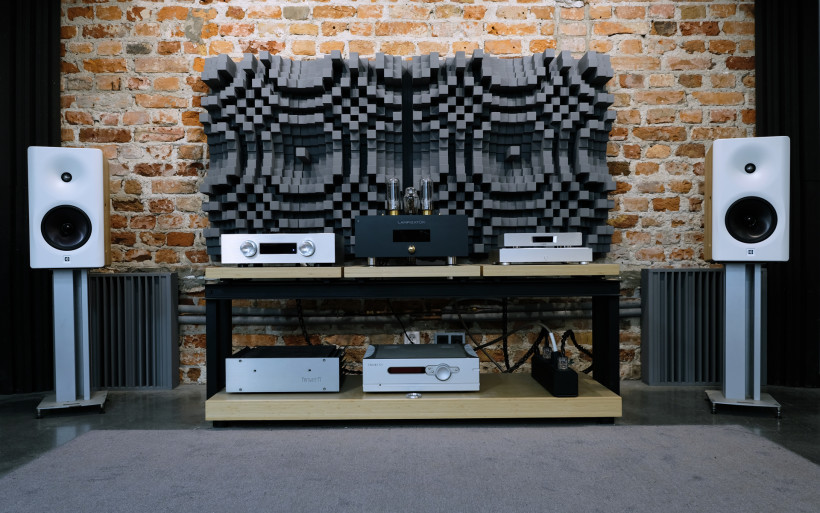 Perfect balance, insightful attitude and fabulous bass weren’t the only tricks the 8c held up its sleeves. Because of the whole audible range served evenly and as equally seasoned, quality recordings always sounded coherently and enjoyably. It didn’t matter whether music was heavy, slow, quick, subtle, minimalist, intimate or loaded with dozens of instruments and spacious. The Dutch skillfully painted the right scenery and allowed me to grasp the view as intended. Another respectable thing this product did was portrayal of musical heft. Ethereal and open tracks remained as such and the same story was with more packed and substantial repertoire. But each and every time smoothness, contour, roundness and stiffness were applied accordingly. This mixture of inherent features in each song at times shifted very drastically from one to another. My Boenicke W8 floorstanders are capable of showcasing this as well, though to a lesser degree in comparison, due to cleaner picture the 8c generated.
Perfect balance, insightful attitude and fabulous bass weren’t the only tricks the 8c held up its sleeves. Because of the whole audible range served evenly and as equally seasoned, quality recordings always sounded coherently and enjoyably. It didn’t matter whether music was heavy, slow, quick, subtle, minimalist, intimate or loaded with dozens of instruments and spacious. The Dutch skillfully painted the right scenery and allowed me to grasp the view as intended. Another respectable thing this product did was portrayal of musical heft. Ethereal and open tracks remained as such and the same story was with more packed and substantial repertoire. But each and every time smoothness, contour, roundness and stiffness were applied accordingly. This mixture of inherent features in each song at times shifted very drastically from one to another. My Boenicke W8 floorstanders are capable of showcasing this as well, though to a lesser degree in comparison, due to cleaner picture the 8c generated.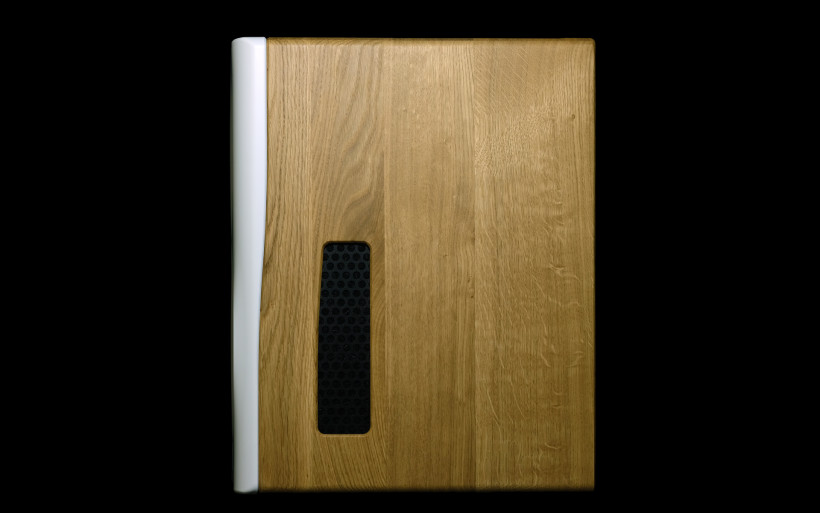 Just as my W8 speakers, Dutch & Dutch 8c also proved to be potent soundstage monster. Well developed in all directions and additionally boosted by roaring yet artfully tamed bass, space this product created was massive and majestic. Early on I thought that my daily driver also known for truly grand imaging stunts sang even bigger on counts such as wideness or height. But some hours into the first listening, this reporter observed that only events in-between both speakers the W8 served a bit deeper, yet sounded more ethereal and a tad diluted in comparison to the 8c. The latter did the same job similarly developed on the sides, it sketched all instruments and vocals more directly yet pinpoint accurately and showed these as gutsier sound sources than its floorstanding competitor. The W8 had these skinnier, more spaced and a bit less present, though differences between the two weren’t big. The most significant one was actually in musical presence, the Dutch sculpted instruments more clearly and with a bit more flesh on their bones, served the first row slightly closer and additionally upped the game via fantastic low FR. On this count my W8 was left in the dust.
Just as my W8 speakers, Dutch & Dutch 8c also proved to be potent soundstage monster. Well developed in all directions and additionally boosted by roaring yet artfully tamed bass, space this product created was massive and majestic. Early on I thought that my daily driver also known for truly grand imaging stunts sang even bigger on counts such as wideness or height. But some hours into the first listening, this reporter observed that only events in-between both speakers the W8 served a bit deeper, yet sounded more ethereal and a tad diluted in comparison to the 8c. The latter did the same job similarly developed on the sides, it sketched all instruments and vocals more directly yet pinpoint accurately and showed these as gutsier sound sources than its floorstanding competitor. The W8 had these skinnier, more spaced and a bit less present, though differences between the two weren’t big. The most significant one was actually in musical presence, the Dutch sculpted instruments more clearly and with a bit more flesh on their bones, served the first row slightly closer and additionally upped the game via fantastic low FR. On this count my W8 was left in the dust.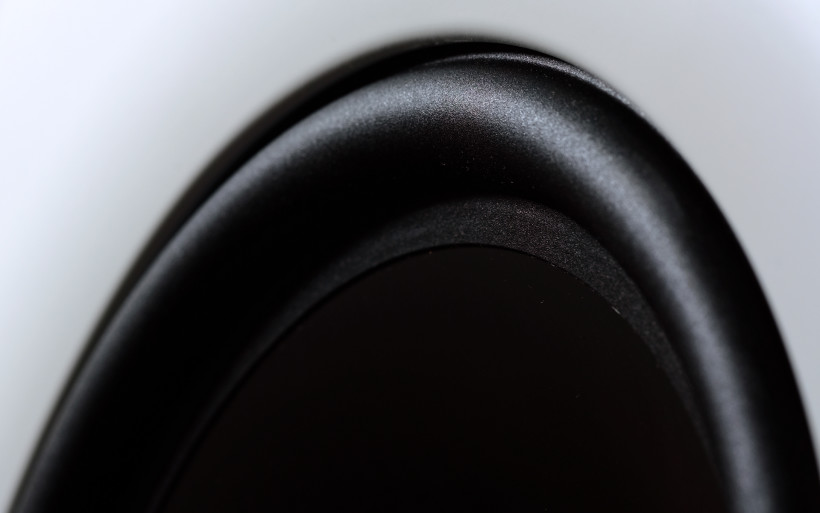 The description above implies that Dutch & Dutch 8c did everything just right and nothing wrong. It can be safely described as a product which sounds evenly, accurately, tonally orderly and balanced, effortlessly, agile, openly and plainly grand. Neither it turned out to be a performer too thin, edgy or shiny, nor too beefy, polite or dimmed. It was coherent all across the board, direct, present, smooth, insightful and precise, whereas its utmost impressive bass slam and control delivered the final blow. I had all intel needed to finally close the chapter and summarize this story, yet the decision was made to test drive my LampizatOr Pacific. This changed a lot.
The description above implies that Dutch & Dutch 8c did everything just right and nothing wrong. It can be safely described as a product which sounds evenly, accurately, tonally orderly and balanced, effortlessly, agile, openly and plainly grand. Neither it turned out to be a performer too thin, edgy or shiny, nor too beefy, polite or dimmed. It was coherent all across the board, direct, present, smooth, insightful and precise, whereas its utmost impressive bass slam and control delivered the final blow. I had all intel needed to finally close the chapter and summarize this story, yet the decision was made to test drive my LampizatOr Pacific. This changed a lot.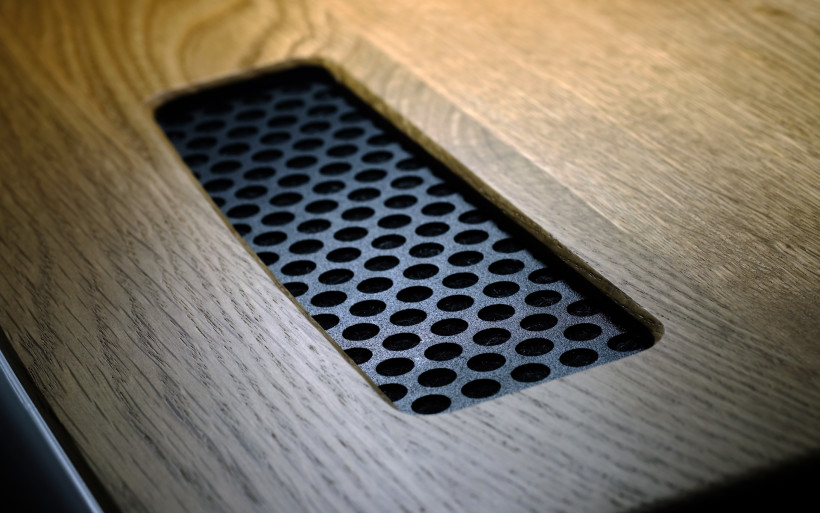 Since my reference source and iFi audio’s Pro iCAN are what they are, it was perfectly reasonable to assume that the 8c fronted by this twosome loaded with valves will net denser, cozier and in general more euphonic and sweeter outcome. Presumably with a drawback or two here and there but overall at least mildly better nonetheless. Martijn informed me that the 8c benefits very little from even posh additions. But surprisingly, his product all alone performed substantially better and the difference was as undeniable as it was shocking. Neither of us saw it coming. My source and preamp on duty trimmed bass reach and extensively desaturated sound to morph it into something less lively, more metallic and audibly worse on most fronts. But most importantly, as a standalone affair the Dutch bested costly hardware additions very easily even in spite of exploiting two things most audiophiles scorn; DSP and digital volume attenuation. My guest didn’t comment the outcome of this comparison in any way other than mild smile and in that particular moment proved me that he had his job down pat. As a proper PR man, Martijn knew very well that any talk which involves other audio operations is either good, or there’s no talk at all. Nicely played, sir.
Since my reference source and iFi audio’s Pro iCAN are what they are, it was perfectly reasonable to assume that the 8c fronted by this twosome loaded with valves will net denser, cozier and in general more euphonic and sweeter outcome. Presumably with a drawback or two here and there but overall at least mildly better nonetheless. Martijn informed me that the 8c benefits very little from even posh additions. But surprisingly, his product all alone performed substantially better and the difference was as undeniable as it was shocking. Neither of us saw it coming. My source and preamp on duty trimmed bass reach and extensively desaturated sound to morph it into something less lively, more metallic and audibly worse on most fronts. But most importantly, as a standalone affair the Dutch bested costly hardware additions very easily even in spite of exploiting two things most audiophiles scorn; DSP and digital volume attenuation. My guest didn’t comment the outcome of this comparison in any way other than mild smile and in that particular moment proved me that he had his job down pat. As a proper PR man, Martijn knew very well that any talk which involves other audio operations is either good, or there’s no talk at all. Nicely played, sir.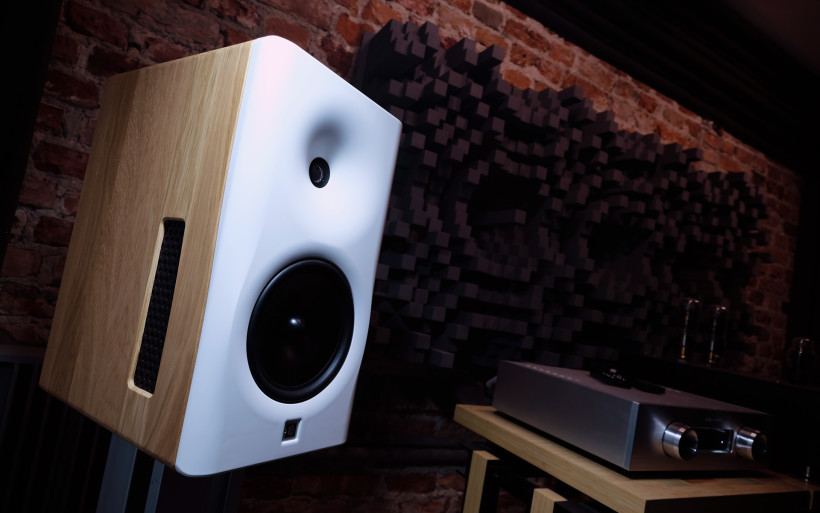 Dutch & Dutch 8c does internal D/A even if it’s fed with analog signal. And several days later Arek Szweda of Sveda Audio confirmed that drastic quality loss both Martijn and me witnessed was double conversion at work. As an experienced engineer and fellow LampizatOr user, he’s been fully aware for years how dreadful to music quality this can be. The man also explained that very expensive ADC needs to be involved in order to limit the effect. Although this might be the case, I wasn’t equipped properly to investigate the subject further, so let’s leave it at that. And lastly, Dutch & Dutch 8c was very subject to transport based triangulations. The difference between my laptop and Lumin U1 Mini was significant to say the least, though that’s a story for another time and the important bit is that quality leap between these machines impacted music the insightful 8c was fed with. It showed any related changes easily, which comes as hardly any surprise at this point.
Dutch & Dutch 8c does internal D/A even if it’s fed with analog signal. And several days later Arek Szweda of Sveda Audio confirmed that drastic quality loss both Martijn and me witnessed was double conversion at work. As an experienced engineer and fellow LampizatOr user, he’s been fully aware for years how dreadful to music quality this can be. The man also explained that very expensive ADC needs to be involved in order to limit the effect. Although this might be the case, I wasn’t equipped properly to investigate the subject further, so let’s leave it at that. And lastly, Dutch & Dutch 8c was very subject to transport based triangulations. The difference between my laptop and Lumin U1 Mini was significant to say the least, though that’s a story for another time and the important bit is that quality leap between these machines impacted music the insightful 8c was fed with. It showed any related changes easily, which comes as hardly any surprise at this point.
Summary
Clever engineering, clear goals, carefully implemented DSP and pro industry experience led the Dutch team to a happy place. All things considered, it’s fair to profile their 8c as the only major audio product most enthusiasts will ever need and a perfectly valid alternative for many regular setups. Not only was the 8c really this good, but it also revealed itself as a true game changer.
We associate affairs similar to the 8c with corners cut, focus not on sound but lifestyle visuals and performance results decent at best yet never spectacular. That’s why many aficionados rolling daily with costly usual suspects will probably find this story very sketchy. If you’re one such an individual, I honestly can’t blame you. After all, how often do we hear an all-in-one product not only capable of trading punches with regular rigs, but also truly able to surpass these where it matters the most? Nonetheless, Dutch & Dutch 8c showed potency very much lethal to one far pricier setup. Put bluntly, on several counts it bested this reporter’s daily platform. Its components are listed down below, you do the math.
The necessity to have AES/EBU capable transport/interface and hardware shifts severely limited due to the 8c’s design were the only two drawbacks I could find. The first one is a small price to pay for what one gets in return and perhaps the company’s implementation of music over IP will reduce mandatory components and increase sound quality even further, time will tell. But limited wiggle room for setup alterations can be liberating. Enthusiasts after all-in-one end game solution and veterans finally ready to play the settle down reduction game will surely appreciate having their hands tied on this count and that’s something their wallets will appreciate as well.
Finely styled and executed, the 8c behaved itself at my place brilliantly and had minimal needs, but most importantly it served music in marvelously voiced, fully blossomed and oftentimes spectacular fashion. This remarkable product delivered nothing short but joy and my ongoing journalistic adventure is the only reason why I haven’t asked for an invoice. This profession demands hardware elasticity and to stay in the game I have to follow accordingly. Nonetheless, after getting familiar with dozens of great products over the years and taking my subjective taste plus living room into account, Dutch & Dutch 8c would be the one I’d go after in a heartbeat. Highly unrealistic to pull off via regular means and for similar coin, it represents the full care package worth every penny. Bravo and ’till next time!
Associated equipment:
- Amplifiers: Trilogy 925, Kinki Audio EX-M1
- Sources: LampizatOr Pacific (KR Audio T-100 + KR Audio 5U4G Ltd. Ed.)
- Speakers: Boenicke Audio W8
- Preamplifiers: iFi audio Pro iCAN
- Transports: Asus UX305LA
- Speaker cables: Forza AudioWorks Noir Concept, Audiomica Laboratory Celes Excellence
- Interconnects: Audiomica Laboratory Erys Excellence
- Power components: Gigawatt PF-2 + Gigawatt LC-2 MK2 + Forza AudioWorks Noir Concept/Audiomica Laboratory Ness Excellence/LessLoss C-MARC
- Rack: Franc Audio Accesories Wood Block Rack
- Music: NativeDSD
Retail prices of reviewed components in EU (incl. VAT):
- Dutch & Dutch 8c: €9‘950
Manufacturer: Dutch & Dutch


